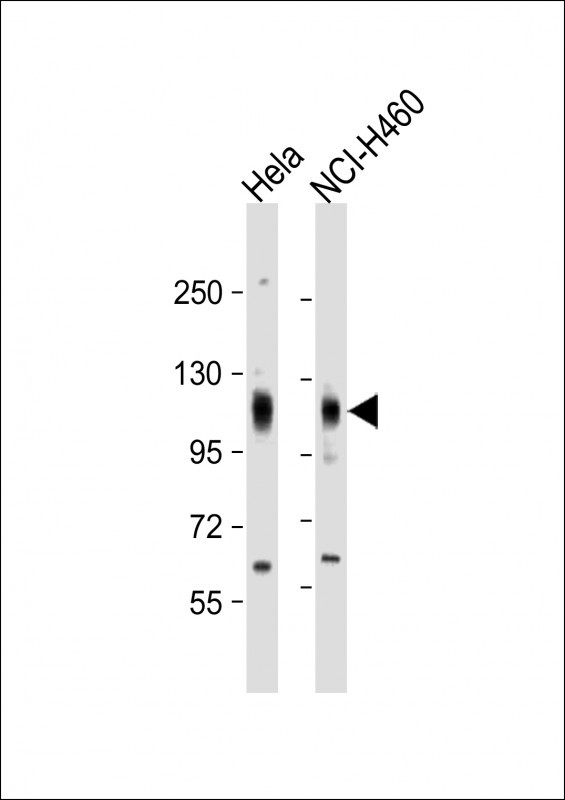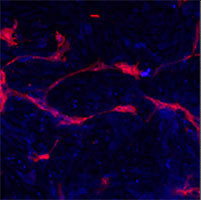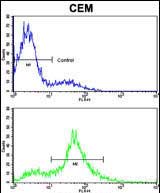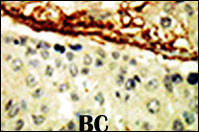Rabbit Polyclonal Antibody to EphA4 (N-term)
货号:
P34048
别名:
Ephrin type-A receptor 4, EPH-like kinase 8, EK8, hEK8, Tyrosine-protein kinase TYRO1, Tyrosine-protein kinase receptor SEK, EPHA4, HEK8, SEK, TYRO1
应用:
WB,IHC,FCM
反应种属:
Human, Mouse
抗体类型:
Primary antibody
Swissprot:
P54764
规格:
目录价
在线咨询
Description |
|---|
Protein kinases are enzymes that transfer a phosphate group from a phosphate donor, generally the g phosphate of ATP, onto an acceptor amino acid in a substrate protein. By this basic mechanism, protein kinases mediate most of the signal transduction in eukaryotic cells, regulating cellular metabolism, transcription, cell cycle progression, cytoskeletal rearrangement and cell movement, apoptosis, and differentiation. With more than 500 gene products, the protein kinase family is one of the largest families of proteins in eukaryotes. The family has been classified in 8 major groups based on sequence comparison of their tyrosine (PTK) or serine/threonine (STK) kinase catalytic domains. The tyrosine kinase (TK) group is mainly involved in the regulation of cell-cell interactions such as differentiation, adhesion, motility and death. There are currently about 90 TK genes sequenced, 58 are of receptor protein TK (e.g. EGFR, EPH, FGFR, PDGFR, TRK, and VEGFR families), and 32 of cytosolic TK (e.g. ABL, FAK, JAK, and SRC families). |
Specification |
|
|---|---|
| Aliases | Ephrin type-A receptor 4, EPH-like kinase 8, EK8, hEK8, Tyrosine-protein kinase TYRO1, Tyrosine-protein kinase receptor SEK, EPHA4, HEK8, SEK, TYRO1 |
| Entrez GeneID | 2043 |
| Swissprot | P54764 |
| WB Predicted band size | 109.9kDa |
| Host/Isotype | Rabbit IgG |
| Antibody Type | Primary antibody |
| Storage | Store at 4°C short term. Aliquot and store at -20°C long term. Avoid freeze/thaw cycles. |
| Species Reactivity | Human, Mouse |
| Immunogen | This EphA4 antibody is generated from rabbits immunized with a KLH conjugated synthetic peptide between 40-70 amino acids from the N-terminal region of human EphA4. |
| Formulation | Purified antibody in PBS with 0.05% sodium azide,1%BSA and 50% glycerol.prepared by Saturated Ammonium Sulfate (SAS) . |
Application |
|
|---|---|
| WB | 1/1000-1/2000 |
| IHC | 1/100-1/500 |
| FCM | 1/10-1/50 |
Product Image
-
All lanes : Anti-EPHA4 Antibody (E55) at 1:2000 dilution Lane 1: Hela whole cell lysate Lane 2: NCI-H460 whole cell lysate Lysates/proteins at 20 µg per lane. Secondary Goat Anti-Rabbit IgG, (H+L), Peroxidase conjugated at 1/10000 dilution. Predicted band size : 110 kDa Blocking/Dilution buffer: 5% NFDM/TBST.

-
Western blot analysis of EphA4 (arrow) using EphA4 Antibody (N-term) (Cat.#P34048). 293 cell lysates (2 ug/lane) either nontransfected (Lane 1) or transiently transfected with the EphA4 gene (Lane 2) (Origene Technologies).

-
Methanol/Acetone fixed human stem cell is used in IF to detect Eph4A (blue) and endothelial Lectin(red). Data kindly provided by Dr. Weis from Cheresh Lab, UCSD.

-
Flow cytometric analysis of CEM cells using EphA4 Antibody (N-term) (bottom histogram) compared to a negative control cell (top histogram). FITC-conjugated goat-anti-rabbit secondary antibodies were used for the analysis.

-
Formalin-fixed and paraffin-embedded human cancer tissue reacted with the primary antibody, which was peroxidase-conjugated to the secondary antibody, followed by DAB staining. This data demonstrates the use of this antibody for immunohistochemistry; clinical relevance has not been evaluated. BC = breast carcinoma; HC = hepatocarcinoma.









 鄂公网安备42018502007531号
鄂公网安备42018502007531号

